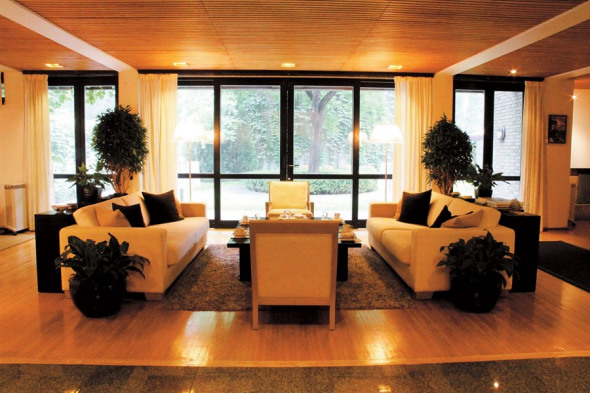 |
| The Norwegian ambassador's residence in Beijing's embassy district depicts the essence of Scandinavian design in the city. — Liu Cheng |
The Norwegian ambassador's residence in Beijing's embassy district stands out as one of the few modernist structures that depicts the essence of Scandinavian design in the city.
The embassy was designed by the Norwegian architect Rolf Ramm Østgaard in 1972 and was one of the first embassies in China designed by a foreign architect. Combining brick and wood in the design, the structure takes elements from both countries: in Norway, houses are traditionally built of wood and in Beijing, brick-made courtyards are common in the city's hutong (maze-like allies). "The concept behind the design, is that the buildings represent a dialogue between our two cultures," said the Norwegian ambassador to China, Svein O. Sæther.
Over the years, many ambassadors and their families have called the residence home.
As the embassy has grown considerably during the last few years, many of the buildings have been made into offices to give space to the new staff.
"With the increasing importance of China in the world, our embassy is likely to continue to grow in the years to come," Sæther said.
The ambassador was lucky enough to be able to move straight into this comfortably appointed house when he took up his post here. "The residence and chancery you see today is a result of a complete refurbishment finished before the Olympic Games in 2008. The art pieces, furniture and decoration were thoughtfully selected for the embassy by the foreign ministry in Norway," said Sæther. The interior style is typical for Norwegian — minimalist and functional. "As most Norwegians, I enjoy natural materials like wood and stone," the ambassador said. "I also appreciate clean lines and discrete colors. It creates a calm atmosphere and allows other elements to take center stage, for instance art or a beautiful table arrangement."
"It's not only a style I personally like, but also the Norwegian king and queen who last visited during the Olympic Games in August 2008 expressed their appreciation for the residence."
The first floor of the residence is used for the ambassador to welcome guests. The garden is also an essential part of the residence design. "Although the embassy is located in one of the busiest areas of Beijing, the garden is tranquil, and the trees and roses make it a comfortable place to be, especially during the summers," the ambassador said.
Every year, the Norwegian national day reception is held in the garden with hundreds of guests enjoying Norwegian salmon and music.
"Throughout my career as an ambassador, I have made a point of using the residence as much as possible for hospitality and events, be it small or large," Sæther said. "In Beijing, the aim of the refurbishment was twofold: First, to make the residence efficient and versatile for hosting everything from 10 to 800 guests. Secondly, to try to create the feeling that you enter a home rather than an institution."
Indeed, the art-filled residence is inviting and cozy. Art is the main attraction, while the furniture, lighting and colors on the walls are all carefully selected to enhance the art pieces.
"We have for example many works by the famous Norwegian painter Edvard Munch," Sæther said. "We celebrated the 150 years anniversary of Munch's birth in Norway last year, and it happened that the artist is also well-known here in China when we invited a group of journalists to the residence introducing the work of the Norwegian painter."
"You might be familiar with Munch's famous painting 'Scream.' We do not have 'Scream' at the embassy, but we have a painting by the Norwegian artist Ole Lislerud called 'Paraphrasing Scream.' It is a contemporary interpretation of the famous painting," he said.
In addition to the many paintings, the interior is also decorated with sculptures and ceramics.
"One of my favorite is 'The Terracotta Woman' by the Norwegian artist Marian Heyerdahl. The sculpture is an example of the dialogue between Norway and China, where a Norwegian artist gives her own interpretation of Chinese ancient history and culture through her artwork," Sæther said.
The ambassador explained that most Norwegians attach great importance to their home and try to make it as comfortable and livable as possible.
"Norway has long winters and short summers, as one thirds of our country is located within the Arctic Circle. This means we like to spend most of the time inside," he said. "Although the residence is an integral part of the embassy, it is important to me that people feel at home and can relax when they come to visit."
"Norwegians love nature," he added. "The slogan of the Norway Pavilion at Shanghai Expo in 2010 was 'Norway — Powered by Nature,' reflecting our closeness to nature. The garden is therefore a way to showcase Norwegian culture to the guests visiting."
Sæther said the city has become a more attractive place to live over the years. He loves to go hiking in the outskirts of the city and enjoys playing tennis at one of Beijing's many courts.
"This year Norway and China mark the 60-year anniversary of diplomatic relations," Sæther said. "Norway and China enjoy a long history together and the cooperation between the two countries covers a wide range of areas. One of our priorities is the Arctic, where Norway and China has mutual interest and common goals. With China's entry into the Arctic Council as a permanent observer in 2013, I'm confident that the Arctic will become an important area of cooperation between our two countries in the years to come."
We recommend:
